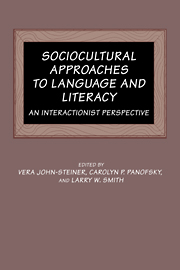Book contents
- Frontmatter
- Contents
- List of contributors
- 1 Introduction
- Part 1 Context
- 2 An interactionist approach to the analysis of similarities and differences between spoken and written language
- 3 Repair in spontaneous speech: A window on second language development
- 4 Struggling for a voice: An interactionist view of language and literacy in Deaf education
- Part II Mediational processes
- Part III Functional systems
- Author index
- Subject index
4 - Struggling for a voice: An interactionist view of language and literacy in Deaf education
Published online by Cambridge University Press: 05 November 2011
- Frontmatter
- Contents
- List of contributors
- 1 Introduction
- Part 1 Context
- 2 An interactionist approach to the analysis of similarities and differences between spoken and written language
- 3 Repair in spontaneous speech: A window on second language development
- 4 Struggling for a voice: An interactionist view of language and literacy in Deaf education
- Part II Mediational processes
- Part III Functional systems
- Author index
- Subject index
Summary
UNDERSTANDING DEAFNESS
We can understand deafness in two ways: as a disabling condition, or as a unique way of perceiving and understanding the world. According to the first view, the essential feature of deafness is the physical condition of not being able to hear. Deaf students are disabled compared to “normal” students – they are hearing-impaired. Under this pathological view, deafness is seen as a potential barrier to students' development into normal, hearing adults. The goal of education is to intervene as early as possible with effective techniques to remediate this condition. Parents, teachers, and other professionals must be prepared to identify social, cognitive, and language difficulties that might arise because of impaired hearing. Specialists are then brought in to treat these disorders.
According to the alternative, cultural view, deaf students are not impaired hearing students any more than Hispanics and blacks are “impaired” Anglos. They are instead people with a different but equally valid view of the world. According to the cultural view, the goal of education is to facilitate deaf students' development into multilingual, multicultural, Deaf adults. Teachers, parents, and others must be alert to situations in which obstacles, misunderstandings, and misinterpretations might arise because of differing views of the world. These become the topics for discussion and learning.
The cultural view does not deny that deaf students experience difficulties. The task is not merely, however, to identify and label these problems but to appropriately interpret their significance.
- Type
- Chapter
- Information
- Sociocultural Approaches to Language and LiteracyAn Interactionist Perspective, pp. 109 - 138Publisher: Cambridge University PressPrint publication year: 1994
- 2
- Cited by



